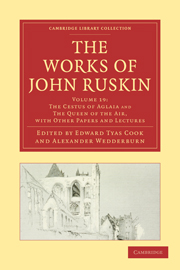Book contents
- Frontmatter
- Contents
- LIST OF ILLUSTRATIONS
- INTRODUCTION TO THIS VOLUME
- PART I “SIR JOSHUA AND HOLBEIN” (1860)
- PART II “THE STUDY OF ARCHITECTURE IN SCHOOLS” (1865)
- PART III “THE CESTUS OF AGLAIA” (1865, 1866)
- PART IV “THE RELATION OF NATIONAL ETHICS TO NATIONAL ARTS,” BEING THE REDE LECTURE FOR 1867
- PART V “ON THE PRESENT STATE OF MODERN ART, WITH REFERENCE TO THE ADVISABLE ARRANGEMENT OF A NATIONAL GALLERY” (1867)
- PART VI “FAIRY STORIES”: A PREFACE TO “GERMAN POPULAR STORIES” (1868)
- PART VII “THE FLAMBOYANT ARCHITECTURE OF THE VALLEY OF THE SOMME” (1869)
- PART VIII “THE QUEEN OF THE AIR” (1869)
- PART IX “VERONA, AND ITS RIVERS” (1870)
- APPENDIX: REPORTS OF ADDRESSES ON ART
- Plate section
PART VI - “FAIRY STORIES”: A PREFACE TO “GERMAN POPULAR STORIES” (1868)
Published online by Cambridge University Press: 05 November 2011
- Frontmatter
- Contents
- LIST OF ILLUSTRATIONS
- INTRODUCTION TO THIS VOLUME
- PART I “SIR JOSHUA AND HOLBEIN” (1860)
- PART II “THE STUDY OF ARCHITECTURE IN SCHOOLS” (1865)
- PART III “THE CESTUS OF AGLAIA” (1865, 1866)
- PART IV “THE RELATION OF NATIONAL ETHICS TO NATIONAL ARTS,” BEING THE REDE LECTURE FOR 1867
- PART V “ON THE PRESENT STATE OF MODERN ART, WITH REFERENCE TO THE ADVISABLE ARRANGEMENT OF A NATIONAL GALLERY” (1867)
- PART VI “FAIRY STORIES”: A PREFACE TO “GERMAN POPULAR STORIES” (1868)
- PART VII “THE FLAMBOYANT ARCHITECTURE OF THE VALLEY OF THE SOMME” (1869)
- PART VIII “THE QUEEN OF THE AIR” (1869)
- PART IX “VERONA, AND ITS RIVERS” (1870)
- APPENDIX: REPORTS OF ADDRESSES ON ART
- Plate section
Summary
1. Long since, longer ago perhaps than the opening of some fairy tales, I was asked by the publisher who has been rash enough, at my request, to reprint these my favourite old stories in their earliest English form, to set down for him my reasons for preferring them to the more polished legends, moral and satiric, which are now, with rich adornment of every page by very admirable art, presented to the acceptance of the Nursery.
But it seemed to me to matter so little to the majestic independence of the child-public, who, beside themselves, liked, or who disliked, what they pronounced entertaining, that it is only on strict claims of a promise unwarily given that I venture on the impertinence of eulogy; and my reluctance is the greater, because there is in fact nothing very notable in these tales, unless it be their freedom from faults which for some time have been held to be quite the reverse of faults, by the majority of readers.
2. In the best stories recently written for the young, there is a taint which it is not easy to define, but which inevitably follows on the author's addressing himself to children bred in school-rooms and drawing-rooms, instead of fields and woods—children whose favourite amusements are premature imitations of the vanities of elder people, and whose conceptions of beauty are dependent partly on costliness of dress. The fairies who interfere in the fortunes of these little ones are apt to be resplendent chiefly in millinery and satin slippers, and appalling more by their airs than their enchantments.
- Type
- Chapter
- Information
- The Works of John Ruskin , pp. 231 - 240Publisher: Cambridge University PressPrint publication year: 2010First published in: 1905

